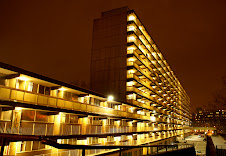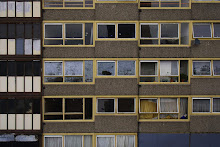
The flatmate says our building is still Band 4, but will be upped to Band 1 in April. The behemoth behind Heygate Road is already Band 1, which explains why so many of the flats have been sealed off by metal barriers. Band 1 is slated for demolition. Technically, the entire estate has been slated for demolition since 2003, with an estimated start time of 18 months. So the flatmate calls the council to find out how long he’ll have past April.
The answer? 18 months.
They’ve demolished at least one of the buildings thus far, a small wing of the estate on the corner of New Kent Road by the overhead railway. Now the concrete gangway which connected the building to the rest of the estate (and, if memory serves me right, to the shopping centre) stops in dead space and is blocked below the stairwell by signs and chain link fencing.
Inside the blue hustings reading ‘Believe in Oakmayne! Believe in the Elephant!’ is a pile of dirt, an earth mover, and a single portable trailer. I haven’t seen any work going on in the two months I’ve been here. On the New Kent Road side of the hustings away from the estate, big color posters show the new development complete with big picture windows and little terraces with nice (white) couples enjoying the view, the train station with a transparent shed roof with coloured panes of glass like a kaliedescope, a refurbished Heygate street with more nice (white) couples strolling down boardwalks and cafes. No pink shopping mall with the paint peeling off the side. No Hannibal House with the grey tinted windows – and no Heygate.
And underneath the pictures: ‘Completion date 2007.’
With the 2012 Olympics closing in, they’ll have to start moving soon. But where will all the tennants go? They have to be rehoused in the Burrough of Southwark. The Aylesbury, itself slated for demolition, is filled to capacity. What will happen to the Elephant in the intervening years when what is now the Heygate Estate becomes a construction zone, filled with the sounds of demolition and construction and heavy equipment by day, the big trucks blocking traffic already strained to the breaking point by diversions and roadworks – and at night, deserted but for a few security guards?
If the working girls are already turning up on New Kent Road when people actually live on the estate, what will it be like for the two, three, five years that the area is essentially abandoned . . .?
Maybe instead of spending billions taking the whole thing down and rebuilding the area into yuppie central (because they can talk all they want about keeping the area’s original character – these new buildings are not going to be built for the people living here now), wouldn’t it be easier and more economical to leave the people where they are and refurbish the estate buildings themselves?
After all, the Alexander Fleming, right on the roundabout, which once housed the DHSS and in 1987 or 88 was voted the ‘ugliest building in Britain’ by one of the tabloids, is now a listed building. A new coat of paint, some basic renovations and hey presto, maybe the Heygate too could become a listed building. Like the Trellick Tower up in Westbourne Park, the design no longer seems so inhuman now. We’ve had time to acclimatize to the scale.
The flatmate say Liz Taylor has bought up five flats in the Alexander Fleming, in anticipation of the flip when the Olympics go through and the whole East End, from Hackney right down to here becomes prime real estate.
The answer? 18 months.
They’ve demolished at least one of the buildings thus far, a small wing of the estate on the corner of New Kent Road by the overhead railway. Now the concrete gangway which connected the building to the rest of the estate (and, if memory serves me right, to the shopping centre) stops in dead space and is blocked below the stairwell by signs and chain link fencing.
Inside the blue hustings reading ‘Believe in Oakmayne! Believe in the Elephant!’ is a pile of dirt, an earth mover, and a single portable trailer. I haven’t seen any work going on in the two months I’ve been here. On the New Kent Road side of the hustings away from the estate, big color posters show the new development complete with big picture windows and little terraces with nice (white) couples enjoying the view, the train station with a transparent shed roof with coloured panes of glass like a kaliedescope, a refurbished Heygate street with more nice (white) couples strolling down boardwalks and cafes. No pink shopping mall with the paint peeling off the side. No Hannibal House with the grey tinted windows – and no Heygate.
And underneath the pictures: ‘Completion date 2007.’
With the 2012 Olympics closing in, they’ll have to start moving soon. But where will all the tennants go? They have to be rehoused in the Burrough of Southwark. The Aylesbury, itself slated for demolition, is filled to capacity. What will happen to the Elephant in the intervening years when what is now the Heygate Estate becomes a construction zone, filled with the sounds of demolition and construction and heavy equipment by day, the big trucks blocking traffic already strained to the breaking point by diversions and roadworks – and at night, deserted but for a few security guards?
If the working girls are already turning up on New Kent Road when people actually live on the estate, what will it be like for the two, three, five years that the area is essentially abandoned . . .?
Maybe instead of spending billions taking the whole thing down and rebuilding the area into yuppie central (because they can talk all they want about keeping the area’s original character – these new buildings are not going to be built for the people living here now), wouldn’t it be easier and more economical to leave the people where they are and refurbish the estate buildings themselves?
After all, the Alexander Fleming, right on the roundabout, which once housed the DHSS and in 1987 or 88 was voted the ‘ugliest building in Britain’ by one of the tabloids, is now a listed building. A new coat of paint, some basic renovations and hey presto, maybe the Heygate too could become a listed building. Like the Trellick Tower up in Westbourne Park, the design no longer seems so inhuman now. We’ve had time to acclimatize to the scale.
The flatmate say Liz Taylor has bought up five flats in the Alexander Fleming, in anticipation of the flip when the Olympics go through and the whole East End, from Hackney right down to here becomes prime real estate.








